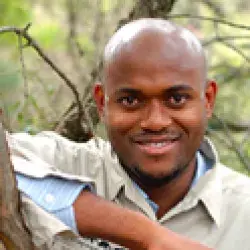Babu and Mama’s Visit to the Leopard Project
This is way overdue, but was eclipsed by numerous events that took place in between. I apologise for that. Following the Aspen Seminar that was held in Johannesburg and Singita Sabi Sand in October 2008, Babu (who is on the AWF’s board of trustees) and Mama visited the leopard project at Singita Kruger National Park (SKNP). Having spent four days with them I got to see and understand how insightful and young at heart they are. As a result I got to relax a little around those two…
Arriving in the Kruger Park, Jared was there waiting together with Sunday. After a brief introduction we took off to SKNP. The trip from the airstrip to SKNP is about 40 minutes, so we got an opportunity to go over the project and what I was doing at that time. We arrived at the lodge and they both decided they would like to rest before going to the field.
About two hours later we drove to the field to check the cameras. Prior to that I warned them that there would be some walking on rocky ridges in order to get to the cameras to which Babu responded “We are tough people, we don’t mind walking!” That was good to hear.
I was planning to take them to my favourite camera station in the south of the concession, a camera that I had high hopes for. The four of us, Jared included, headed for the bush. We checked the first camera, which was not far from the lodge. The camera had taken only nine images, the last image taken the day that I left (the day that I put in fully charged batteries!). I knew then that it would be downhill from there, I still had my hopes pinned on the special camera in the ridges though.
Checking the camera trap for leopard photos... without luck this time.
The second camera had five images. That’s when my head started spinning and disappointment and despair took over. “We’ll find something in the next camera”, I tried to put on a brave face. Somehow Mama and Babu could see beyond that.
We then moved on to the third camera, the one. For this one we had to walk for a good thirty minutes and along the way while Jared talked about a whole lot of things regarding nature, I didn’t hear a thing. My thoughts were on the next camera, the one that I thought would give results we would all like to see.
We arrived at the camera. It was in a drainage line that looked like a perfect leopard’s hangout spot. In front of it there was a nice rock that I thought would be a lovely place for a leopard to relax. I was so confident about this camera that I asked Babu to sit on the rock in front of the camera so the camera could capture him. We then opened the camera anticipating images with Babu’s image rounding it all up.
Results: Number of images: 16 minus Babu Leopard pictures: what leopard? The look on my face: you don’t wanna know
The camera trap caught a bird... but that's about it.
I was very disappointed. How can this camera pull off something like this? One would think that if a camera can capture a bird in flight it should pick up a person walking.
I therefore stop here with the report on our camera trap checking exercise.
The evening on the other hand was very beautiful. We got an opportunity to view the sunset, which in my mind was spectacular. We then drove towards the border with Mozambique and in the middle of all that immense beauty the disappointing camera stunts were briefly forgotten.
We still had a great time. Here is "Babu" and me with a chameleon.
I have to say the landscape here is quite lovely. Jared then drove us to the gorge where we spent some time discussing constellations; one of them, the teapot. That is when Babu and Jared started comparing their pointers while pointing at the “Teapot”. I didn’t have any, although I had the spotlight in my hand. The thought of joining the conversation and pointing out that the spotlight that I had would fit in as one of the tools crossed my mind, but I discarded the thought as being dull. After a while and a series of numerous other discussions we headed back to the lodge and discussed the project:
During dinner that night Babu and Mama said the following: • There seems to be a lot of inconsistencies with the cameras, i.e. some took only a few pictures and others a lot (I have to say this: the one camera had 1600 pictures, a different more expensive model) • What about the days in between capturing? Tough question… • You may want to consider going to communities and talking to kids and inform them about what you are doing. January 23rd 2009, I will spend time with children and teachers from Echo-Schools in the Limpopo Province. • Don’t give up!
Then it was time for the BIG lesson: The eighty twenty rule. According to this rule - also called the Pareto Principle - 80% of the effects come from 20% of the causes. In other words, once the project is all set up, you put in 20% effort to get more than 80% of results. Now that’s what I call insight!
With this I would like to thank Babu and Mama for taking their time and resources to come and visit the leopard project and share in its development.



